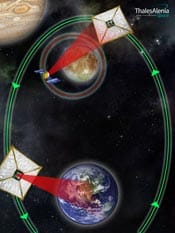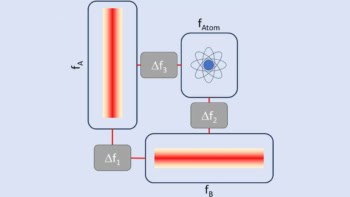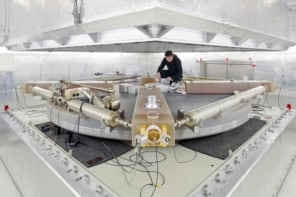
Engineers at Thales Alenia Space in France say it is possible to slash the amount of time needed to transport planetary data back to Earth by using spacecraft propelled by solar radiation. These “data clippers” could in principle shuttle continuously between Earth and the outer planets, returning large volumes of data decades earlier than is possible with conventional radio transmissions.
Satellites studying planetary bodies that are relatively nearby, such as the Moon and Mars, can transmit data back to Earth fairly quickly via a radio link. Missions observing more distant planets, however, face a problem because the 1/r2 attenuation in radio waves over these greater distances renders the signal sufficiently weak that transmission must be slowed down in order to guarantee that radio antennas on Earth can intercept the data.
As an example, says Thales’ Joël Poncy, a full high-resolution map of Jupiter’s moon Europa or Saturn’s moon Titan would require about 10–20 terabytes worth of data. However, data could not be sent via a radio link faster than about 1 gigabyte per day, which, he points out, means a transmission time of around half a century. More advanced optical links would be a little quicker, he says, perhaps taking around 20 years to complete the dispatch.
Sailing on a photon breeze
Poncy and colleagues at Thales have studied an alternative – data clippers. These spacecraft would use large lightweight “sails” that are pushed forward by the very slight but continuous radiation pressure of the photons emitted by the Sun. With onboard steering devices these clippers could be directed around the solar system so that they pass close to conventional spacecraft orbiting distant planets or moons, upload data from the spacecraft to an onboard flash memory using a laser beam and then perform a flyby of Earth, during which they download the data, again using the laser, to a ground station.
By passing within a few tens of thousands of kilometres of the orbiting spacecraft and of Earth, the divergence of the laser beam would be small enough to guarantee a fast data transmission rate – up to 1 gigabyte per second – and the data transport would therefore be limited simply by the time that it takes the clipper to travel from the planetary body back to Earth.
Speaking to delegates at the European Planetary Science Congress in Rome recently, Poncy said that he and his colleagues have proved the viability of data clippers by carrying out orbital mechanics calculations. He said they worked out that a data clipper could reach Europa, after accelerating by making several orbits close to the Sun, within about six years and it would then take three years to put itself on the right trajectory to be able to make a flyby of Earth. As he pointed out, that figure of three years compares favourably to the roughly 50 years that would be possible using current radio technology. The clipper could then in principle perform many more such upload and download cycles, visiting a different planetary orbiter each time.
Strong sailcloth needed
The Japanese Space Agency currently has a solar-sail-powered spacecraft, known as IKAROS, cruising towards Venus. According to Poncy, however, several technological hurdles need to be overcome in order to make solar sails suitable for data clippers. These include the development of a lightweight but strong material from which to make the sails – one possibility being a woven mesh of carbon nanotubes. Among the other challenges are how to unfold the huge 150 × 150 m sails in space and how to make the spacecraft sufficiently manoeuvrable so that they can approach the planetary orbiters but do so without propellant.
The development of data clippers is likely to take about 20 years and cost between €100m and €200m. Poncy says that government support will be essential; although he points out that his company has yet to make a formal request for funding from the European Space Agency. Speaking to physicsworld.com, ESA’s director of science and robotic exploration David Southwood described data clippers as “an interesting concept” but one “for the day after tomorrow rather than tomorrow.” He also queried Poncy’s claim that downloading data is “the major design driver” for interplanetary missions, maintaining that it is, in fact, “one problem of quite a few.”



